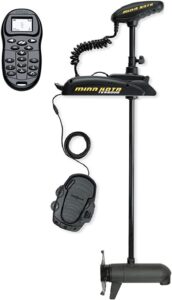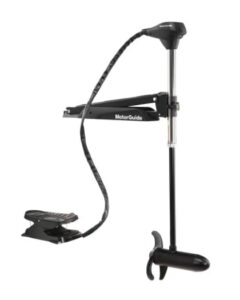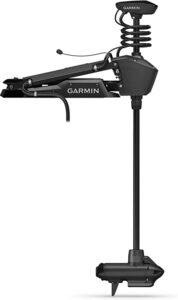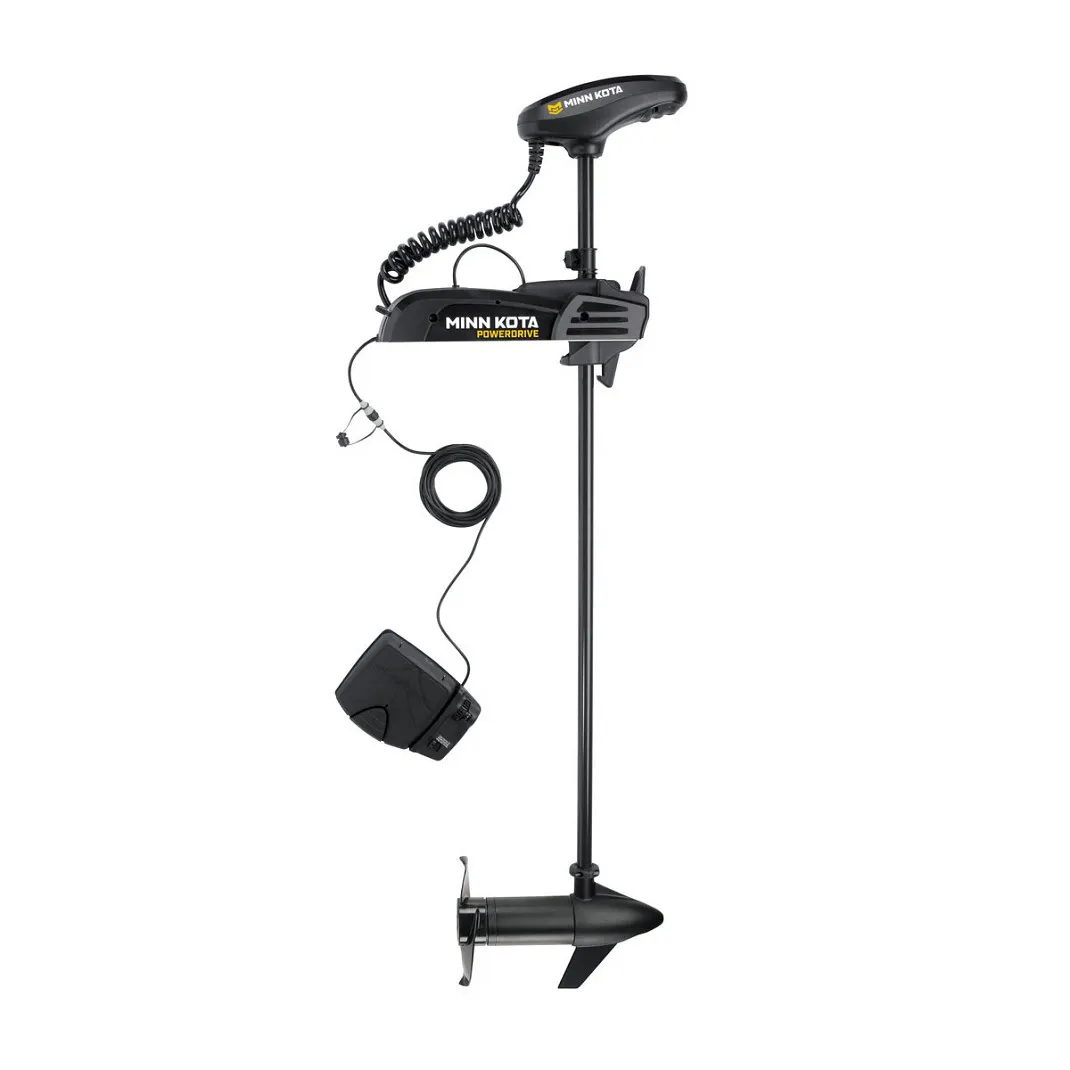| Minn Kota Terrova i-Pilot | MotorGuide x3 Freshwater Trolling Motor | Garmin Force Trolling Motor |
|---|---|---|
 |
 |
 |
| Water Compatibility: Freshwater | Water Compatibility: Freshwater | Water Compatibility: Freshwater, saltwater, and brackish |
| Thrust: 55 lbs / 80 lbs / 112 lbs | Thrust: 45 lbs / 55 lbs / 70 lbs | Thrust: 80 lbs., 100 lbs. |
| Voltage: 12 V / 24 V / 36 V | Voltage: 12 V / 24 V | Voltage: 24 V / 36 V |
| Speed Control: Variable | Speed Control: 5 forward, 2 reverse / 5-speed/variable | Speed Control: 20 power settings |
| Control Type: Control Type Foot pedal, remote | Control Type: Hand, foot | Control Type: Wireless foot pedal; handheld remote |
| Mount Type: Bow | Mount Type: Bow, pontoon | Mount Type: Bow |
| Shaft Length: 45” / 54” / 60” / 72” | Shaft Length: 36”, 45”, 50” | Shaft Length: 50", 57" |
| Shaft Material: Composite | Shaft Material: Stainless steel, composite | Shaft Material: Fiberglass |
| Propeller Type: 2-blade weedless wedge prop (MKP-32/33) | Propeller Type: 2-blade / 3-blade | Propeller Type: Garmin High-Efficiency Propeller (2 blades) |
| Battery Capacity: Variable | Battery Capacity: Variable | Battery Capacity: Dependent on usage |
| Maximum Amp Draw: 50A/56A/52A | Maximum Amp Draw: Variable | Maximum Amp Draw: 57 amps, 54 amps |
| Warranty: Lifetime (shaft), Limited 2-year (rest of motor) | Warranty: 2-year limited warranty | Warranty: 3-year warranty; limited lifetime warranty on the shaft |
| Spot Lock: Yes | Spot Lock: No | Spot Lock: Yes |
| Fish Finder Connectivity: Yes (Humminbird with i-Pilot Link) | Fish Finder Connectivity: No | Fish Finder Connectivity: Yes |
| Best Price (Amazon) | Best Price (Amazon) Best Price (Bass Pro) | Best Price (Amazon) |
CONTROL
When it comes to effortless, intuitive control of your pontoon boat, the Minn Kota Terrova i-Pilot is in a class of its own. The Terrova comes equipped with a huge suite of advanced digital features tailored for pontoons. For example, the GPS anchor lock (or "Spot Lock") enables you to keep your pontoon locked into a fixed position regardless of wind or current. This makes it easy to stay parked over a productive fishing spot. The cruise control feature lets you dial in a set speed, allowing the boat to move steadily without constant adjustments.
Integration with Humminbird fish finders via the i-Pilot Link system takes the Terrova's navigation capabilities even further. Right from your Humminbird screen or the wireless remote, you can view sonar imaging and GPS mapping to precisely maneuver your pontoon boat by sight. The wireless i-Pilot remote also gives you complete fingertip control of steering, speed, anchor lock, and cruise control. All of these innovative features work together to let you place your pontoon boat exactly where you want it with minimal effort.
When handling a heavy, cumbersome pontoon boat, having a trolling motor with computer-assisted intelligence is a game changer. The automation provided by the Minn Kota Terrova gives you advanced autopilot for your pontoon boat, allowing you to focus on fishing instead of constantly fiddling with steering and positioning. The Terrova brings digital navigation into the realm of pontoon boating.
THRUST
The Garmin Force is the undisputed champion when it comes to delivering maximum thrust to drive a pontoon boat. With its 80 and 100 lb thrust capacities, the Garmin Force simply outputs more brute force than the other two motors. Its high-tech brushless motor provides incredible torque while remaining nearly silent. When running at full power, the Garmin Force moves with speed yet maintains outstanding energy efficiency.
These attributes make it an exceptional motor for pontoon boats, which tend to be heavier and more cumbersome than other vessels. The extra thrust helps a pontoon plane faster, overcome drag, and power through challenging conditions like wind, waves, and strong currents. Even large, heavily loaded pontoon boats with more passengers onboard can be easily motored by the Garmin Force. Simply put, its brawny design makes it the only choice when you need to push heavy pontoon boats with authority.
Another major advantage of the Garmin Force for pontoon boats is its long, durable shaft. With 50" and 57" shaft length options, the motor can be installed at the optimal depth to generate maximum thrust on a pontoon boat. The long shaft provides clearance underneath the massive pontoons while putting the prop far enough into the water for excellent thrust transfer and maneuverability. Built to stand up to saltwater, the rugged Garmin Force has the brute strength and shaft length that makes it purpose-built for even the biggest pontoon boats.
MOUNTING
For simplified mounting on a pontoon boat, the MotorGuide x3 is purpose-engineered for the task. The entire mounting system is designed from the ground up with pontoon boats in mind. The bracket is shaped to easily fit on pontoon tubes and rails while providing rock-solid support for the motor. Composite locking pins on the mount keep the unit stable and vibration-free when stowed or deployed.
The MotorGuide x3's composite shaft is designed to stand up to the rigors of deployment and operation on a pontoon boat. It holds up well to bumps and scrapes from the pontoon without compromising sturdiness. The 50" shaft length provides good depth flexibility without compromising stability. Overall, the MotorGuide x3 has a rugged build engineered for the unique demands of pontoon trolling.
Even in rough water, the vibration-dampening mounts coupled with the MotorGuide x3's robust construction keep the motor running smooth and steady with minimal shaking. The responsive steering and proportional foot pedal speed control make navigating very intuitive. Streamlined speed selection settings simplify operation compared to units with an excessive number of speed presets.
In every way, the MotorGuide x3 provides a reliable, purpose-built system for simplified mounting and operation on a pontoon boat. The time saved on installation, ease of deployment, and rugged performance make it the go-to choice when selecting a trolling motor optimized for pontoon boat usage.

Selecting the ideal trolling motor is one of the most important decisions when outfitting your pontoon boat. The right trolling motor acts as your pontoon’s steering wheel and engine, allowing you to maneuver precisely and cruise efficiently.
However, pontoon boats have unique requirements when it comes to trolling motors. Their large size, weight, and build characteristics demand a trolling motor designed specifically with pontoons in mind.
In this comprehensive guide, we’ll cover the key factors to evaluate when selecting the best trolling motor for your pontoon boat.
Here are some key considerations when shopping for the ideal trolling motor for your pontoon boat:
Pontoon boats have special considerations when it comes to trolling motors.
The number one consideration for a pontoon trolling motor is thrust. Thrust determines the raw power and pushing force the motor can generate to move your boat.
Pontoon boats are heavy. Average sized 20+ foot pontoons can weigh over 2000 lbs. Larger, multi-toon pontoon party boats can exceed 4000 lbs. That’s a lot of mass to get moving.
That’s why you need ample thrust - 80 lbs or more is recommended for most pontoon applications. Large and heavy luxury pontoons may need 100+ lbs of thrust. Forceful power is crucial to getting a pontoon on plane and overcoming resistance.
Look for powerful motors like the Garmin Force or Minn Kota Ultrex that offer 80, 100 lb, or even 112 lb maximum thrust levels. High-torque brushless motors also provide excellent thrust while remaining energy efficient.
For pontoons under 20 ft, you may be able to get by with 55-70 lb motors. But more thrust is better to really optimize performance. Don’t handicap your pontoon with an undersized trolling motor.
Once you’ve got the power to move your pontoon, being able to control it with precision is crucial. The control system includes features like wireless connectivity, GPS integration, and autopilot modes.
Advanced motors like the Minn Kota Terrova i-Pilot offer integrated wireless remotes. This allows you to control steering, speed and GPS lock modes from anywhere on the pontoon.
Remotes with built-in GPS utilizing anchor lock are extremely useful. They allow you to lock your pontoon in a fixed position with the touch of a button. This makes staying over a fishing hotspot or holding position in current a breeze.
Other great features to look for are cruise control to maintain a consistent trolling speed and integration with onboard fish finders. This allows you to view navigation info and sonar imaging right on the remote.
When it comes to controlling heavy, cumbersome pontoon boats, the more intuitive “smart” features the better. The automation allows you to focus on fishing, watersports and entertaining instead of driving.
Installing and mounting the trolling motor securely is critical on a pontoon boat. The unique tube frame demands a specialty bracket designed for pontoons.
Many trolling motors like the MotorGuide XI3 come with purpose-built mounting kits for pontoons. The bracket shape matches the rails and design, while providing incredibly sturdy support.
Others like the Minn Kota Terrova offer addon pontoon mounting accessories. Either way, ensure the bracket fits your specific pontoon design and tubes properly.
The mounting hardware should prevent excessive vibration, even when running at higher speeds in choppy water. Good mounting allows you to deploy and stow the motor smoothly and securely.
Don’t try to jerry rig a normal bow mount trolling motor - take the time to get a proper pontoon-specific mounting system. This ensures solid performance and reliability.
Shaft length is also a key consideration for pontoon trolling motors. Longer shafts provide better clearance underneath the massive pontoons while putting the prop deeper in the water.
Look for shaft lengths from 50-60” to find the ideal balance of depth and height. This allows you to immerse the prop fully when deployed, while still providing adequate clearance underneath the pontoons when stowed.
Shorter shafts around 36-42” may lack proper depth when deployed and hit the pontoons when raised. But a shaft that’s too long can lead to instability and vibration issues.
Getting the proper pontoon trolling motor shaft length for your boat allows you to run smoothly in the optimal depth range for power and control.
Durability is also essential in a trolling motor for pontoon boats. The motor will inevitably endure bumps, scrapes and abuse from the metal framework over time.
Key areas to evaluate are the composition of the shaft and the construction of the mount and head. Look for solid composite or stainless steel shafts that resist flexing and corrosion.
The mount should be firmly braced and the head assembly reinforced to withstand occasional knocks from the pontoons. Brands like Minn Kota are revered for their rugged reliability.
Don’t cheap out on a flimsy pontoon trolling motor that won’t hold up over time. The beating it takes demands robust materials and solid design engineering tailored for toughness.
Beyond the main factors above, here are a few other things to factor when selecting your pontoon trolling motor:
Finding the perfect trolling motor is crucial to unlocking the full potential of your pontoon boat. Pay close attention to thrust, control systems, mounting, shaft length, and durability when shopping for your pontoon trolling motor.
Take the time to choose the right model purpose-built for your specific pontoon’s size, weight and usage demands. This ensures you get the optimum blend of power, efficiency, maneuverability and reliability for maximizing your time out on the water.
For most pontoon boats, the Minn Kota Terrova or Ultrex are excellent choices. With their integrated GPS anchor modes and wireless remotes, they provide superb maneuvering control. They also come in 80, 100lb+ thrust models to power even big, heavy pontoons. The mounting kits are purpose-built for pontoons and the long composite shafts are durable. When you add it all up, the innovative features plus power and construction quality make the Terrova and Ultrex hard to beat for pontoons.
The ideal trolling motor shaft length for most pontoon boats ranges from 50 to 60 inches. This provides adequate clearance underneath the pontoon tubes when stowed, while still immerging the prop fully when deployed. Shorter 36-42” shafts often lack proper depth when down. Overly long shafts can lead to stability issues. Take measurements of your specific pontoon’s setup to dial in the optimal shaft length taking bridge height, deployment depth needs, and stowed clearance into account.
For average sized 20-24 foot pontoons, you'll want a minimum of 80 pounds of thrust. Larger and heavier luxury multi-toon pontoons often demand 100-112 pounds of thrust to optimize power and handling. The extra thrust helps big heavy pontoons get on plane faster and provides more control in current and wind. Take the time to match your pontoon's weight, passenger capacity and performance goals when choosing thrust. More is generally better, within weight limits. Don't handicap a heavy pontoon with an undersized trolling motor.